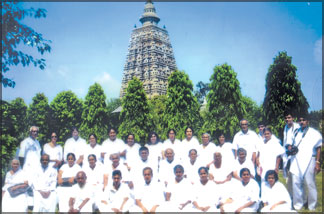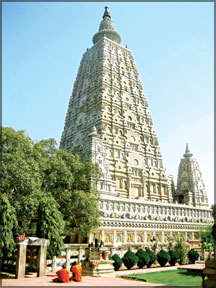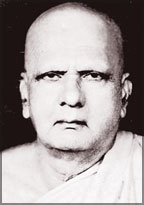Buddhist Spectrum
Seeing about Bodh Gaya
Rupa BANDUWARDENA
Pilgrimage to Dambadiva is one that every Buddhist makes sometime in
his or her life. Because it is very much a part of our culture,
heritage, our Buddhist background and atmosphere. Millions of people
from all over the world do visit Dambadiva - a place of many marvels
purely religious and sacred, pertaining to the all wise all
compassionate Buddha - Sakya Muni Gautama.
His doctrine and the message of Dhamma was for the whole world, to
all mankind irrespective of colour, caste and creed. India’s greatest
attraction to Buddhists overseas lies in these sacred places where
Thathagatha, the Perfect One was born, attained enlightenment lived
disseminating his Dhamma displaying his wisdom, intellect and masterly
knowledge of the doctrine, finally Parinibbana during which time the
Thathagatha had declared that these are going to be sacred sites of
Buddhist worship as mentioned in the Mahaparinibbana Sutta:
Birth place - Lumbini
Buddhahood - Bodh Gaya
First sermon - Saranath
Parinibbbana - Kusinarawa
These are places of sanctity not to be missed. These sacred sites
display interesting facts about ancient history of Buddhism.
These sacred sites stand today to tell us about the origin and
evolution of Buddhism.
|

A group of Bodh Gaya pilgrims |
The history of the doctrine is clearly unfolded to the devotees keen
to know the eternal truth.
These venues stand to tell us the most significant unforgettable
tales of the Buddhist era, in the presence of our own eyes.
They display and record important events in Thathagatha’s life and
identify places associated with him.
These sacred sites give one a feeling of piety and serenity like the
temples, dagabas and religious monuments.
It is believed that if Buddhists visit these places of worship they
will never see the sight of four hells (Sathara Apaya) as all their sins
will be washed away with this visit to Punya Bhoomi. All these bear
testimony to the Buddha’s stay, the glory and prosperity that followed.
These sacred places - Chaitya and its premises temples have been
declared archaeological preserve by the State Government of India. Bodh
Gaya.
I wish to make special mention of Bodh Gaya the great marvel
unparalleled in history, the place where Sakyamuni Gautama Buddha
attained the supreme enlightenment, the most significant event in human
history, the most sanctified place that should be visited by devoted
Buddhists. This is where he sat in meditation in his search of bliss
free from Jara, Vyadhi, Marana.
He was determined to find the eternal truth. Enlightenment downed
upon him. For Noble Truths were revealed. He became the Buddha for the
relief of the entire humanity. Ever since Bodh Gaya became the most
venerated spot and a place of pilgrimage for devotees from Buddhist
countries.
Thanks to the royal patronage of the Great Emperor Asoka who worked
tirelessly for the propagation of Buddhism restoring many sacred venues.
A rock edict mentions Asoka’s visit to Bodh Gaya in the 3rd Century BC
and he is considered the founder of the Mahabodhi temple. It is believed
that he built a shrine with a canopy over Vajrasana the seat of
enlightenment. The temple architecture is remarkable.

The temple rises gracefully to a height of 52 metres in the form of a
pyramid on a basement of 15 metre square. The greatest attraction is the
glittering colossal image of the Buddha in the inner chamber in touching
the ground pose (Bhumisparsha Mudra). Its legendary beginnings will be
of interest to the pilgrims. The legend revealing the origin of the
statue is a breathtaking marvel.
It is a divine creation. It is said that when the temple was being
constructed the idea to enshrine a statue could not be fulfilled due to
the inability of finding an efficient sculptor. In his search for a
suitable person, one day a man emerged saying “I can do it.” He
requested to provide him with a pile of scented clay and a lit lamp
placed in the inner chamber with the door locked for six months.
The request was complied with, but the impatient devotees had opened
the door four days before the declared date. Inside there was a
glittering statue perfect in every detail but for a small space in
front-chest area to be completed. Little later a Bhikkhu who was asleep
in the inner chamber had a dream in which Bosat Maitriya had said that
it was he who had made the statue.
A close study had revealed that it was truly a divine creation
presently the most revered statue in the Buddhist world resembling the
Buddha the exact way, built at the very place where Buddha sat in
meditation. The serene statue is even more glittering though it is
believed to be over 1700 years old.
The first Chinese monk Fa Hsien and also another scholar monk Tibetan
named Dharmaswami provided much information about the past history of
Bodh Gaya, how it had been saved from Turushkas the dreadful enemies,
the plunderers. Another prominent figure was Anagarika Dharmapala who
travelled to Bodh Gaya to secure it to the custody of the Buddhist world
from anti Buddhists. He established the Mahabodhi Society of India in
1891 and built the modern pilgrims’ rest at Bodh Gaya, which is of
enormous service to present day pilgrims.
The other important places connected to this Punya bhoomi are the six
locations where Sakyamuni continued to meditate for seven weeks in
gratitude for his final search of the eternal truth. These sacred spots
are found around the Bodhi premises. The Sacred Bodhiya is surrounded by
a golden railing built by the late President Premadasa.
We enjoyed our most sacred ever wonderful pilgrimage organised by the
‘People’s Travels’ managed by the People’s Bank. People’s Travels put up
a splendid performance a unique task without a parallel.
We the pilgrims witnessed a magnificent journey in full comfort. The
journey throughout was giving a sense of comfort, relief elegance and
security. They ensured the security of the pilgrims at every turn giving
them a sense of protection. We the pilgrims became one family in a
matter of few days.
After days travelling, we rested in the hotels provided, to be
prepared for the next day - a busy tomorrow. We are awake after a short
sleep, yet feeling quite fit. In the morning we visit the sacred places
and pay homage to the Triple Gem. We worshiped to our hearts content.
We set out daily according to a set programme with two travel guides.
They were highly accomplished historians and educationists of high
calibre the choice of the People’s Travels. They never failed to
enlighten us on the history, location and the significance of the places
of worship right through the journey.
We reach a different destination each day. The thrill of entering
sacred premises is beyond words - treasured by everyone of the group.
Another special feature was the arrangements made to meet the Bhikkhus
who perform an inestimable service in convincing us of the importance
attached. They make the pilgrims participate in religious functions
fervently.
The sacrifice and services of the Buddhist monks should be commended
for the impressive record of protection and maintenance provided. Their
deep concern should be appreciated.
Anyone of the pilgrims who wishes to donate for the upkeep of the
sacred places are free to make their contributions which they do
lavishly. In the course of the long distance traveling the pilgrims not
only had intellectual religious discussions, but also devotional song
recitals presented by the clever singers in the crowd, enjoyed by
everybody in the bus.
Ven. Mahopadyaya Aluthgama Dhammananda A felicitation ceremony
Nirmala SAMARASINGHE
A public meeting will be held on November 22 at 3 pm at Senkadagala
Eksath Bauddha Mandalaya’s hall, Angarika Dharmapala Mawatha, Kandy to
felicitate Ven. Mahopadyaya Aluthgama Dhammananda Nayake Thera, senior
member, Karaka Sangha Sabha, Malwatte Chapter on his attaining 94 years
by Buddhist societies in Kandy and its suburbs.

Born in 1915 at Aluthgama near Thumpane in Kandy district to Maha
Arambe Rajakaruna Wasala Dukganna Ralahamillage Dingiri Banda, a Village
Headman and Herath Mudiyanselage Ranmenike. Named as Heenbanda, he
received his primary education at Muruddeniya and Idamegama colleges.
He was ordained as a novice under the tutelage of Ven. Pahamune
Dharmakeerthi Sri Sumangala, the then Maha Nayake of Malwatte Chapter
and Ven. Aluthgama Sri Piyadassi Nayake Thera. He received his education
at Sri Sangaraja Pirivena, Kandy and received higher ordination at the
Uposathagaraya of Malwatte Maha Viharaya.
In 1936 he founded Sri Mahinda Daham Pasala at Ampitiya and was the
head teacher until 1950. He started the Katina Cheevara Pooja of
Malwatte Maha Viharaya in 1944 and held the 65th Cheevara Pooja
recently. State and foreign patronage have been received for most of the
katina pinkamas. In 1950 he started teaching at Dharmaraja College,
Kandy and served until 1958 without any remuneration. In 1958 he got a
government teaching appointment and served as a teacher at Gurudeniya
Vidyalaya and from 1966 to 1972 again at Dharmaraja College.
He inaugurated Sri Sangaraja Gunanusmarana Sangamaya, Kandy, in 1947
and held the Sri Sangaraja perahera uninterruptedly for 62 years. He
founded the Sri Sangaraja Kantha Sangamaya and Sri Sangaraja Daham
Pasala in 1951.
As the Buddhist Chaplain at Bogambara prisons from 1950 onwards he
has pioneered in the construction of a Viharaya, Chaithya and
Bodhi-prakara at the premises at Pallekele open-air prison. A Dhamma
school has been inaugurated in the name of Sir Richard Aluvihare, the
first Sri Lankan IGP, for the benefit of children at police quarters in
Kandy.
In 1951 he started the Poya Day Sil programme at Malwatte Maha
Viharaya which exists to-date. Under his patronage, Sri Vaishakadana
Sangraha Samithiya was inaugurated which pioneered in the onstruction of
Keppetipola pilgrims rest.
When the then Government decided to donate a governmental land
adjoining the Sri Dalada Maligawa to the church, he opposed that move
and was successful in obtaining that land to Sri Dalada Maligawa.
Pilgrims’ Rest of Sri Dalada Maligawa stands on this land. He has
started a scholarship scheme for the benefit of students attending his
alma-mater, Muruddeniya Maha Vidyalaya.
I was fortunate to hear about a miracle which occurred after the
Nayake Thera performed a Satya Kriya at Isipatana Migadaya, the place
where the Buddha delivered his first sermon.
He was the president of Sasanarakshaka Mandalaya of Kadawath Sathara
and Gangawata Korale for the past 32 years and presently serves as the
president of Kandy District Sasanrakshaka Mandalaya and a patron of
Samastha Lanka Sasanarakshaka Mandalaya.
Following the instructions of the Nayake Thera, the Kandy Municipal
Council changed the street names of Victoria Drive to Sri Sangaraja
Mawatha, Glen Dale Road to Saranankara Mawatha and the road leading to
his avasa as Welivita Mawatha.
He initiated the issue of postage stamps by the Postal Department on
the occasion of the 200th anniversary of passing away of the Sangaraja
Thera and 225th anniversary of establishing the Upasampada at Malwatte
Maha Viharaya.
In 1973 he was appointed for Thewava at Sri Dalada Maligawa and in
1989 appointed to the Karaka Sangha Sabha of Malwatte Chapter.
In 1990, he was appointed ‘Mahopadyaya’ of the Malwatte Chapter by
the late Ven. Sirimalwatte Ananda Maha Nayake Thera.
He has travelled to UK, Japan, Singapore, Malaysia, Thailand and
India for Buddhist missionary work.
History was created on the 6th January 2001 when he was conducted in
a perahera consisting of Kandyan dancers and elephants when he was
conducted from Malwatte Maha Viharaya to Palipana Chandananda Buddhist
Research Institute, Asgiriya Maha Viharaya at a felicitation ceremony
held on his behalf organised by the Ven. Medagama Dhammananda and the
Ven. Kumbukkandanwala Punnaratana Theras of Asgiriya Maha Viharaya with
the assistance of all Buddhist societies of Kandy and its suburbs and
chaired by the Ven. Galagama Sri Attadassi Saranankara Anu-Nayake Thera
of Asgiriya Chapter.
History was created once again on 29th January 2006 when Maha Nayake
Theras of all three Nikayas, Siyam, Amarapura and Ramanna sat together
for a Sanghika Dana, held at the ‘Thumpane Pansala’ of Malwatte Maha
Viharaya on the occasion of attaining 91. A deputation of Maha Sangha
from Thailand also attended this Sanghika Dhana.
On January 28 a felicitation ceremony was held at the main hall of
Dharmaraja College, Kandy, presided over by the Mahanayake Thera of
Asgiriya Chapter. Two Anunayake Theras of Malwatte Chapter, Secretary of
the Kotte Chapter, Ven. Professor Bellanwila Wimalaratana Nayake and the
Prime Miniter Ratnasiri Wickramanayake were present. A sannasa was
presented to the Ven.
Aluthgama Dhammananda Nayaka Thera for the services rendered by him
to the Sasana and the world by Kandy Mayor Kesara Senanayake which was
signed by all members of Kandy Municipal Council.
May our Venerable Nayake Thera live many more years surpassing the
hundredth year serving the Sasana and the world.
ABHIDHAMMA IN A NUTSHELL - XII:
Common features of all Minds
Shamika SOYSA
One who wishes to learn Abhidhamma in depth and expecting to apply it
to understand and answer intricate questions of world and living beings
must first by-heart 89 or 121 types of Chiththas with their proper
meanings, functionality and applicability. Similarly, 52 types of
Chethasikas are also to be by-hearted with an understanding of their
meaning and applicability in various Chiththas at different situations.
From this episode onward, the 52 types of Mental States would be
described quite in detail.
Annasamana Chethasikas
Universals - Sabba Chiththa Sadharana Chethasika (seven)
It was mentioned in the previous episode that there are 13
Chethasikas which arise both with Kusala and Akusala Chiththas and they
are known as Annasamana Chethasikas. The first category of Annasamanas
is seven types of “Universal Mental States” or Sabba Chiththa Sadharana
Chethasika named as such as though they are found in every Chiththa in
common. Seven of them are;
1. Phassa - Contact
2. Vedhana - Feeling
3. Sanna - Perception
4. Chethana - Volition
5. Ekaggatha - One-pointedness
6. Jivithindriya - Psychic life
7. Manasikara – Attention
(1) Phassa - Contact
When describing Chiththas it was mentioned that consciousness arises
when one of our six sense organs meet with an object. The mental state
or the Chethasika which arises when an object presents itself to the
consciousness through one of the six senses is “Contact” or Phassa.
(2) Vedhana - Feeling
Recall that every Chiththa was associated or connected with mental or
physical feelings of Somansassa (Pleasure), Dhomanassa (Displeasure),
Upekkha (Indifference) and Dukkha (Pain), Sukha (Happiness). The feeling
described there was the second universal mental state and that is called
as ‘Feeling’ or Vedhana.
(3) Sanna - Perception
Sanna or “Perception” in this context is the mental state which
recognises a particular object and its characteristics differentiated
from another. When consciousness acquires an object Sanna is the mental
state which identifies the nature of that object based on previous
perceptions and the one which would record features for future
perceptions.
(4) Chethana - Volition
Chethana or Volition plays a predominant part for every action one
performs. Chethana fulfils its own function in raising the consciousness
and coordinates other mental states as well. Chethana is the effort to
perform any action.
Kamma happens based on the Chethana preceded by the time one is
performing any action. Therefore Chethana is a compulsory mental state
arises with any Chiththa.
(5) Ekaggatha - One-pointedness
In order for a consciousness to arise at least for a fraction of a
moment mind should be focused on one object. That mental state is known
as “One-pointedness” or Ekaggatha. When an aspirant is achieving Jhana
states this is one of the mental states improved to obtain extensive
concentration on one particular object.
(6) Jeevithindriya - Psychic life
Not only mind but also the matter depends on Jeevithindriya and
Jeevithindriya depends on mind and matter. This mental state provides
life for Chiththa and Chethasika just like food provides life for our
body. It will help Chiththa - Chethasika generations to exist until
attaining Nibbana.
(7) Manasikara - Attention
Turing the mind towards the object is the chief characteristic of
“Attention” or Manasikara. Therefore there is no mind without Manasikara.
It directs the mind towards the object over and over again as and when
mind leaves the object.
It should be now clear that the above mental states are compulsory to
be associated with any consciousness. The next six Annasamanasas are
particulars, which contained in Chiththas, depending on the situation.
Next episode will describe Prakirnaka Chethasikas or Particulars in
detail.
Reference: Abhidharma Margaya by Ven. Prof. Renukane Chandhawimala
Thera,
A Manual of Abhidhamma by Narada Maha Thera
[email protected]
|



